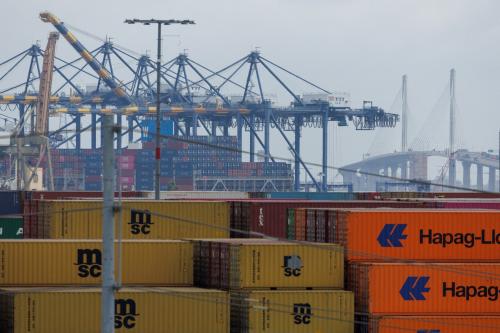 In the three months since the EU-Turkey migrant pact came into force, the number of migrants arriving on Greek shores has dropped precipitously. But the number of migrants making the even more dangerous crossing to Italy has increased substantially. After months of chaos, Rome—having adopted a variety of measures in partnership with European authorities—is now much better prepared than last summer to deal with a new migrant surge. But, despite its efforts, Italy—like its peers—cannot possibly cope on its own with a new wave of migration on the order of magnitude as the one witnessed last summer.
In the three months since the EU-Turkey migrant pact came into force, the number of migrants arriving on Greek shores has dropped precipitously. But the number of migrants making the even more dangerous crossing to Italy has increased substantially. After months of chaos, Rome—having adopted a variety of measures in partnership with European authorities—is now much better prepared than last summer to deal with a new migrant surge. But, despite its efforts, Italy—like its peers—cannot possibly cope on its own with a new wave of migration on the order of magnitude as the one witnessed last summer.
Yet that possibility is real. With almost 19,000 arriving from Libya in the first three months of this year, an EU-Libya migration compact is urgently needed. But for it to work, Europe as a whole must engage with Libya comprehensively and across policy areas. That will require time—and an interim solution in the meantime.
Fewer arrivals in Greece, more in Italy
Notwithstanding its many flaws, the EU-Turkey deal appears to be working at deterring people from making the treacherous crossing from Turkey to Greece. Although weather conditions have improved, the number of migrants reaching Greece dropped by 90 percent in April, to less than 2,700. Syrians, Pakistanis, Afghans, and Iraqis made up the bulk of new arrivals, as has been the case for the last few months. Further north, along the Western Balkans route, the number of migrants reaching Europe’s borders in April dropped by 25 percent, down to 3,830. In this case, Macedonia’s de facto closure of its southern border with Greece clearly contributed to stemming the flow.
With the Eastern Mediterranean and the Western Balkans routes sealed, the Central Mediterranean pathway presents new and worrying trends. In the month of April alone, 9,149 migrants arrived in Italy. As in the past, they were overwhelmingly from Sub-Saharan Africa (mostly Nigeria), many of them economic migrants unlikely to be granted asylum. For the first time since May 2015, more migrants are now reaching Italy than Greece. Many more are likely to have lost their lives trying to do so.
For the first time since May 2015, more migrants are now reaching Italy than Greece.
Learning from past mistakes
Italy is doing its homework. A revamped headquarters for the European Union Regional Task Force (EURTF) overseeing migrant arrivals across the Central Mediterranean opened at the end of April in the town of Catania. Five of its six hotspots—first reception centers fully equipped to process new arrivals—are now in place, with a combined reception capacity for 2,100 people and the involvement of Frontex, the European Asylum Support Office, Europol, Eurojust, the International Organization for Migration, and the Office of the United Nations High Commissioner for Refugees. Fingerprinting rates have now reached virtually 100 percent at all active hotspots. Long-term reception capacity across the country is currently at 111,081, and plans are in place to boost this to 124,579. This would probably not be enough to host the share that the country could be expected to take under a permanent and fair pan-European relocation mechanism. And yet, at least for the time being, the European Commission judged the Italian reception system to be more than sufficient.
Within this context, European partners seem to be slowly becoming more confident in Rome’s willingness to take up its responsibilities. It is no coincidence that on the same day that German Finance Minister Wolfgang Schäuble invited Vienna to support Italy in its efforts to control migrant movements within the Schengen area, Austria’s Interior Minister Wolfgang Sobotka announced that work on building a “migrants protection fence” at the Italy-Austria border was halted.
A sustainable solution before it’s too late
Still, should a new massive migrant wave reach its shores, Italy could not cope on its own. Indeed, no single European country could. Should such a new wave materialize, Libya would be by far the most likely country of origin. Italy is the key to fighting ISIS and stabilizing Libya, but it would be unrealistic to expect Italy to do so on its own.
The current European migrant crisis is part of a broader global refugee crisis and Europe has a shared interest and responsibility in dealing with it. Because of that, an EU-Libya deal is now necessary. This must—and can—be better than the agreement between the EU and Turkey. But a strategic pan-European approach is urgently needed. As Mattia Toaldo recently highlighted, a joint EU-Libya migration plan would be one of five priority areas for Libya. These would also include supporting a Libyan joint command to fight ISIS, a diplomatic offensive in support of the recently-established unity government, a reconciliation of local militias through power devolution, and the re-launch of the country’s economy. In April, Italy shared proposals with its European partners for a new migration compact with Libya but which also involves the broader region. That might be wise: since Europe is certainly unable to stabilize Libya in the short term, its leaders should start thinking about the country as a variable within a far broader equation.
What can Italy do in the meantime?
The European Union should step up its support for Italy and an interim solution to migrant crisis in the Central Mediterranean must be found. Meanwhile, Italy has to brace itself for the potential arrival of over 800,000 migrants currently in Libya and waiting to cross the Mediterranean. While Rome could never cope with such a surge in migrant flows on its own, it still can—and must—plan for such an eventuality.
Three measures could be taken to address this challenge. First of all, Italy could consider setting up a seventh—and possibly even an eight—hotspot. This would be an important step given that an idea Italian Interior Minister Angelino Alfano floated—to set up “hotspots at sea”–is unlikely to be viable on both legal and humanitarian grounds. Second, Italy should increase its long-term reception capacity to around 150,000 people. The exact number would depend on the calculations that the European Commission is currently finalizing. Crucially, this should mirror the number of individuals beyond which an emergency relocation mechanism would be activated to re-distribute asylum seekers from Italy to another EU member state. Finally and should a sudden surge in the number of arrivals materialize, Italy could prepare contingency plans to mobilize virtually its entire navy to support ongoing EU efforts with its Operation Sophia. These policy proposals involve a significant effort in terms of state capacity. Yet, Italy has both a moral responsibility as well as a vested interest in implementing them.
p>



Commentary
Is Italy the new Greece? New trends in Europe’s migrant crisis
June 13, 2016